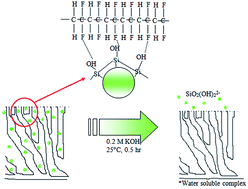Alkaline etching treatment of PVDF membrane for water filtration
Abstract
The exposure of poly(vinylidene fluoride) (PVDF) membranes to alkaline solutions is known to have a deterioration effect on the mechanical and thermal stability of the membranes. On the positive side, this leads to extensive pore formation via the etching process. Previous studies conducted on the etching process involved the use of high chemical concentrations and temperatures which could degrade the membrane, as well as the use of hazardous chemicals. Therefore, in this work a mild potassium hydroxide (KOH) solution was used as a mild chemical agent. A PVDF membrane incorporating silicon dioxide (SiO2) was prepared by an immersion precipitation method. The etching treatment was conducted using mild KOH solution. Upon exposing the silicon dioxide filled membrane to both 0.01 M and 0.2 M concentrations of KOH, membrane pores were introduced without any sign of dehydrofluorination observed on the membrane. The 0.01 M and 0.2 M KOH treatments resulted in PVDF membranes with increased water permeability up to 291.20 L m−2 h−1 and 387.39 L m−2 h−1, respectively. EDX analysis indicates that the SiO2 particles were dissolved more efficiently under treatment with 0.2 M KOH for 30 min compared to the treatment with 0.01 M KOH. The results also showed that the surface roughness decreased, whereas the pure water flux and Bovine Serum Albumin (BSA) rejection increased after the etching treatment with mild KOH. The mechanical properties of the treated membrane remained unchanged throughout the experimental procedure.


 Please wait while we load your content...
Please wait while we load your content...